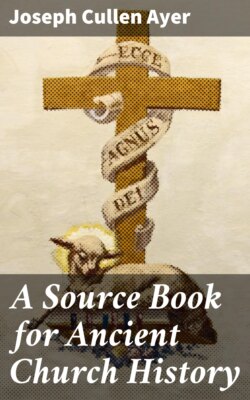Читать книгу A Source Book for Ancient Church History - Joseph Cullen Ayer - Страница 116
На сайте Литреса книга снята с продажи.
(b) Irenæus, Adv. Hær., III, II:8. (MSG, 7:885.)
ОглавлениеThe following extract illustrates the allegorical method of exegesis in use throughout the Church, and also the opinion of the author that there were but four gospels, and could be no more than four. It should be noted that the symbolism of the beasts is not that which has become current in ecclesiastical art.
It is not possible that the gospels be either more or fewer than they are. For since there are four regions of the world in which we live, and four principal winds, and the Church is scattered over the whole earth, and the pillar and ground of the Church is the Gospel and the Spirit of Life, it is fitting that she should have four pillars, breathing forth immortality on every side, and giving life to men. From this it is evident that the Word, the Artificer of all, who sitteth upon the cherubim and who contains all things and was manifested to men, has given us the Gospel under four forms, but bound together by one Spirit. As also David says when he prayed for His coming: “Thou that sittest between the cherubim, shine forth” [cf. Psalm 80:1]. For the cherubim, also, were four-faced, and their faces were images of the dispensation of the Son of God. For he says, “The first living creature was like a lion” [cf. Ezek. 1:5 ff.], symbolizing His effectual working, leadership, and royal power; the second was like a calf, symbolizing His sacrificial and sacerdotal order; but “the third had, as it were, the face of a man,” evidently describing His coming as a human being; “the fourth was like a flying eagle,” pointing out the gift of the Spirit hovering over the Church. And therefore the gospels are in accord with these things, among which Christ is seated. For that according to John relates His original, effectual, and glorious [pg 121] generation from the Father, thus declaring, “In the beginning was the Word and the Word was with God and the Word was God” [cf. John 1:1 ff.], and further, “All things were made by Him and without Him was nothing made.” For this reason, also, is that Gospel full of confidence, for such is His person. But that according to Luke, which takes up His priestly character, commenced with Zacharias, the priest, who offers sacrifice to God. For now was made ready the fatted calf, about to be immolated for the recovery of the younger son [Luke 15:23]. Matthew, again, relates His generation as a man, saying, “The book of the generation of Jesus Christ, the son of David, the son of Abraham” [Matt. 1:1]; and “The birth of Jesus Christ was on this wise” [Matt. 1:18]. This, then, is the gospel of His humanity; for which reason the character of a humble and meek man is kept up through the whole gospel. Mark, on the other hand, commences with reference to the prophetical Spirit who comes down from on high to men, saying, “The beginning of the Gospel of Jesus Christ, as it is written in Isaiah the prophet,” pointing to the winged aspect of the Gospel, and on this account he makes a compendious and brief narrative, for such is the prophetical character. And the Word of God himself had intercourse with the patriarchs, before Moses, in accordance with His divinity and glory; but for those under the Law He instituted a sacerdotal and liturgical service. Afterward, having been made man for us, He sent the gift of the heavenly Spirit over all the earth, to protect it with His wings. Such, then, was the course followed by the Son of God, and such, also, were the forms of the living creatures; and such as was the form of the living creatures, such, also, was the character of the Gospel. For the living creatures are quadriform, and the Gospel is quadriform, as is also the course followed by our Lord. For this reason four principal covenants were given mankind: one prior to the Deluge, under Adam; the second after the Deluge, under Noah; the third was the giving of the law under Moses; the fourth is that which [pg 122] renovates man and sums up all things in itself by means of the Gospel, raising and bearing men upon its wings into the heavenly kingdom.
